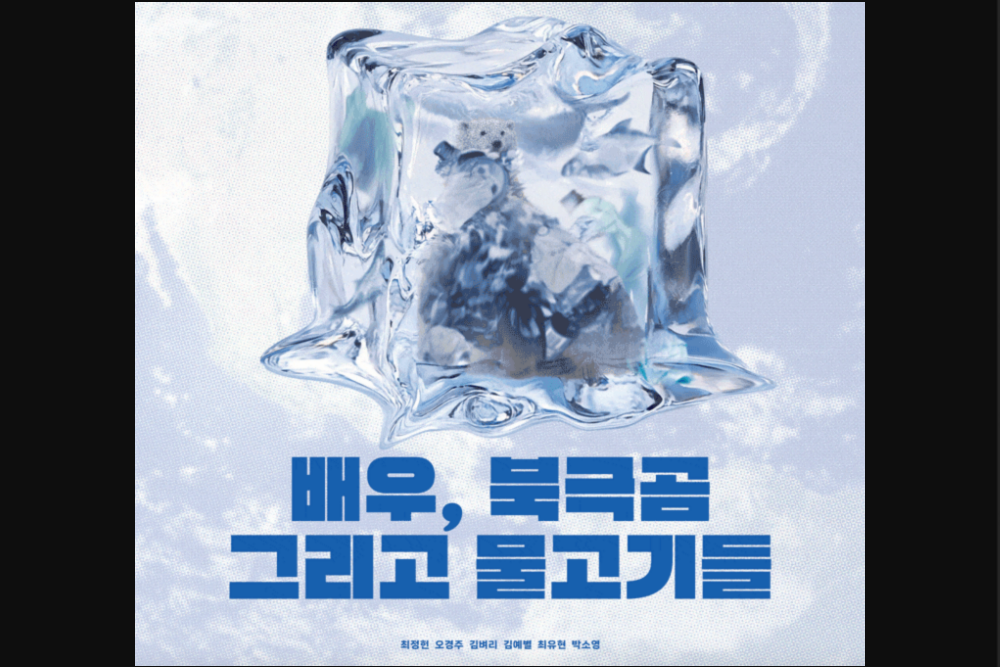Introduction: Sustainable Performing Arts
“Sustainable Performing Arts” refers to performance art that takes into account the current state of the planet and aims to be maintained over the long term. In the arts sector, there is a growing trend toward using not only environmentally friendly materials and energy during the production process, but also incorporating eco-art and other sustainable practices into the artworks themselves. Art has the unique ability to capture public attention and convey powerful social messages. Given that the climate crisis is a global issue, utilizing the arts as a medium to raise awareness and engage the public could serve as an especially effective strategy. Increasingly, a variety of artistic genres—including installation art and performing arts—are addressing climate issues, helping to highlight the severity of the crisis and call for urgent change. Beyond simply creating environmentally friendly work, sustainable art practices now often include collaboration with local communities, resource reuse, and efforts to reduce carbon footprints. But why is this particularly important in the arts? Perhaps it is because the arts not only deliver social messages but also have the potential to model sustainable practices, thereby amplifying their impact across society.
The carbon emissions from the performing arts sector may be relatively low compared to other industries. So why is it still important to reduce emissions in this field? One key reason is that the arts play a crucial role in driving social change. By actively practicing sustainability, the performing arts can inspire other industries to follow suit. Moreover, climate change can have a direct impact on performance venues and audience accessibility. From extreme weather events disrupting events to long-term shifts affecting infrastructure and travel, the effects of climate change pose real challenges to the performing arts ecosystem.
In practice, festivals involve significant carbon emissions at every stage—from planning and preparation to execution—due to energy consumption, waste generation, and transportation. Among these, travel by audiences, performers, and staff accounts for a substantial portion of a festival’s total carbon footprint. Additionally, witnessing the large amounts of waste discarded on-site and the resources wasted throughout the event raises the question: are we consuming energy and generating waste for what is essentially a one-off entertainment experience? This highlights the importance of the performing arts and festival industries taking responsibility by measuring, documenting, and planning to reduce their carbon emissions. Such efforts are essential to moving toward a more sustainable cultural sector.
In an effort to reduce carbon emissions, cultural and artistic sectors both in Korea and abroad are actively seeking ways to respond to the climate crisis. For example, the ‘Sustainable ACC Content Production Guidelines’ published by the Korea Culture & Tourism Institute in 2021 propose a step-by-step framework for creating exhibition content. These guidelines offer practical strategies for internal stakeholders, creators, and audiences to contribute to sustainability efforts. This reflects a growing recognition within the industry that systematic management is essential. Rather than prioritizing only the convenience of artists and audiences, it is important to consider the overall environment in which performances take place. This includes planning for sustainability across every phase—planning/preparation, production/operation, and post-event stages. By outlining specific actions for each stage and offering recommendations that can be referenced by stakeholders at all levels—organizers, artists, and audiences alike—the guideline emphasizes that real progress toward sustainability is only possible when all parties commit to meaningful change.
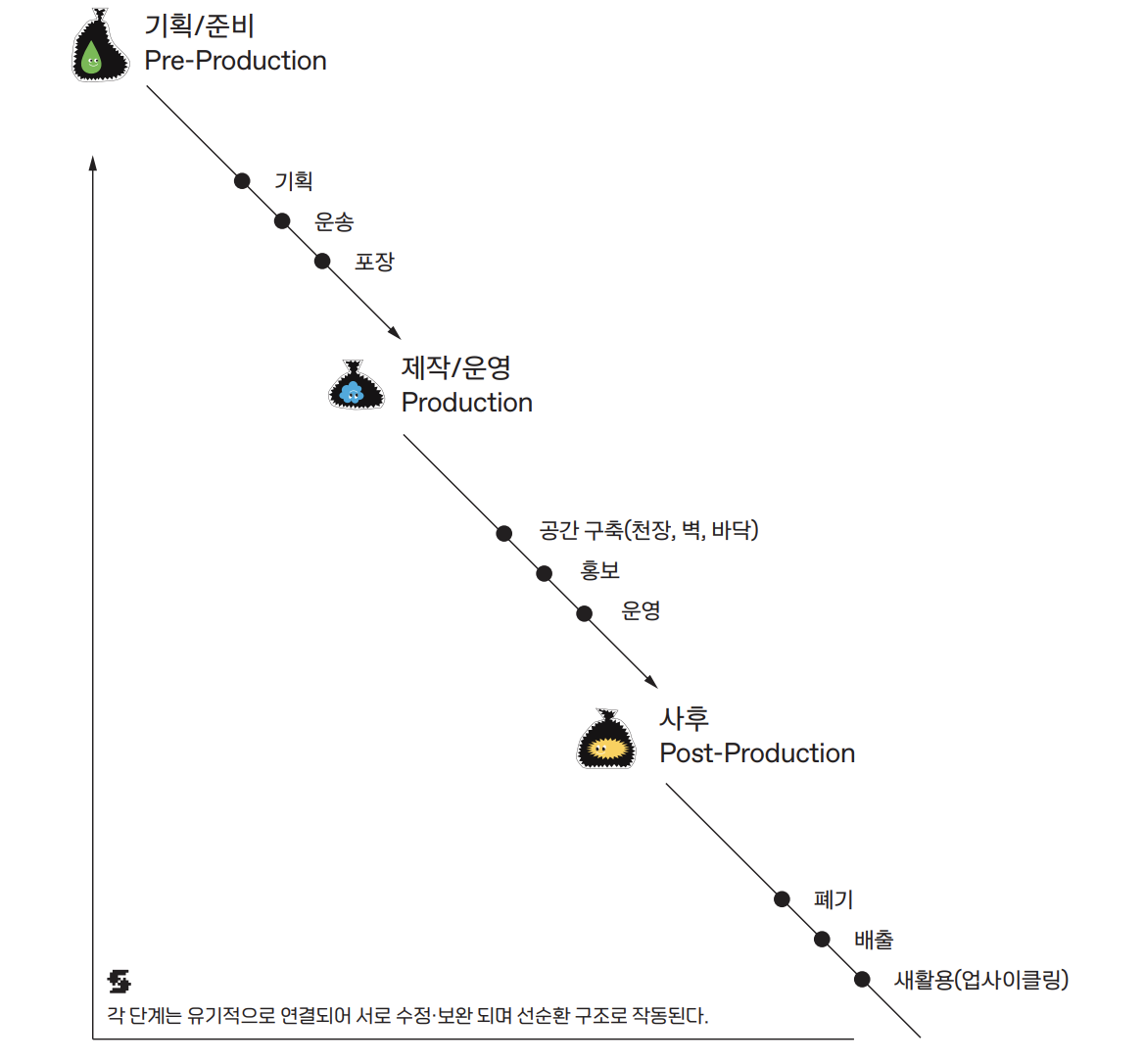
<Figure 1> Sustainable ACC Content Production Guidelines (2021)
(Source: Asia Culture Center, 2024)
In many countries, the cultural and arts sectors have already taken proactive steps to address the climate crisis. In the UK, for example, music performances alone are responsible for an estimated 400,000 tons of carbon emissions annually. Given the scale of the industry, stakeholders tend to have a high level of awareness about the issue and are actively working to find and implement solutions.
Furthermore, the UK government has established sustainability policies aimed at minimizing the negative social and environmental impacts of events. One such effort is the implementation of the international event management standard, ISO 20121, which was notably applied during the London 2012 Olympics. This raises the question: who is responsible for the carbon emissions produced by festivals? The answer involves multiple stakeholders, including audiences and local authorities. Even if not all festivals are centered on environmental themes, it is essential that their environmental impact is managed responsibly. Festivals should play an active role in addressing the climate crisis—one of the most urgent challenges of our time—by considering and mitigating their ecological footprint.
Powerful Thinking, a UK-based cooperative think tank, was established to address energy-related issues within the festival sector. In response to the 2015 United Nations Climate Change Conference in Paris, the organization published a report that assessed the environmental impacts of festivals and proposed industry-wide strategies to reduce those impacts. A study of 279 summer music festivals in the UK revealed that, as of 2013, around 3 million festival-goers attended annually. Of the total carbon emissions generated by these events, approximately 80% came from audience travel. The remaining on-site emissions were attributed to energy use (65%) and waste generation (35%). To mitigate these impacts, Powerful Thinking has supported various initiatives. These include collaborating with the ‘Love Your Tent’ campaign to reduce the number of abandoned tents after festivals, sourcing supplies from ISO-certified providers, using composting toilets to reduce water consumption, and adopting low-transportation or localized options to minimize emissions associated with logistics.
Although carbon emissions from water usage during events are relatively small compared to those from energy consumption or waste, they are recognized as a valuable area for broader sustainability efforts. For example, the Shambala Festival bans the sale of drinks in single-use bottles, and some attendees have reduced plastic waste by purchasing tumblers as part of the ‘Bring a Bottle’ initiative. Additionally, when purchasing tickets for the Shambala Festival, an automatic recycling deposit is added, which is refunded to attendees who bring back waste collected during the festival. The price of all vehicle and campervan tickets also includes a carbon offset donation to Ecolibrium, with the full amount invested in renewable energy projects.
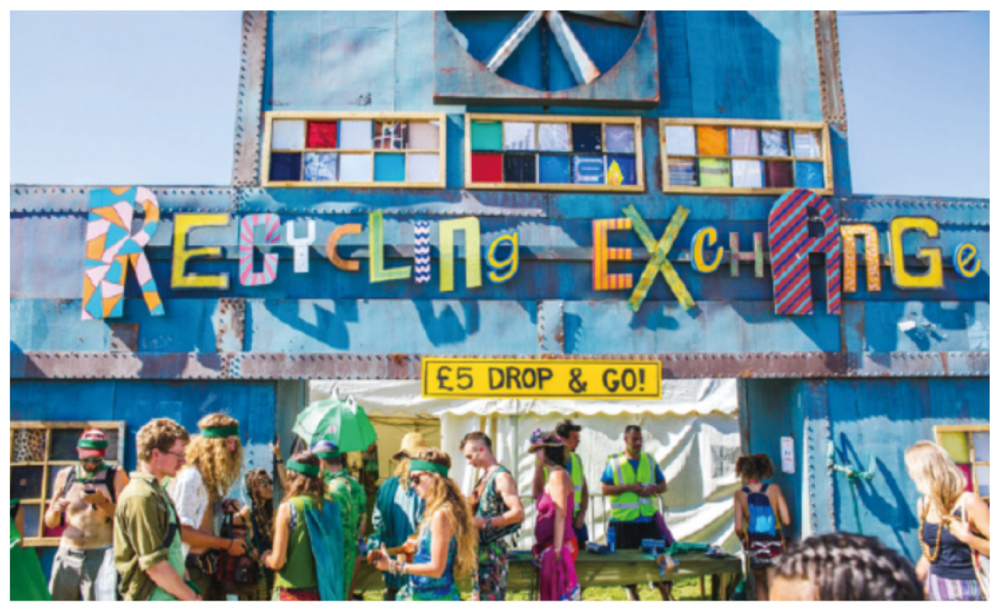
(Source: Shambala Festival Website, 2023)
Among various examples, the ‘Seoul Fringe Festival’ stands out as a laboratory for sustainable artistic practices. In particular, voluntary participation and diversity provide a foundation that enables sustainable change. When environmentally conscious approaches are applied throughout the creative and production processes, sustainability transcends being merely an obligation; it becomes a value that aligns with the freedom and creativity that fringe festivals strive to embody. With the belief that small changes can create powerful waves, the Seoul Fringe Festival—emphasizing freedom, creativity, and an experimental spirit without being bound by traditional art forms—serves as an ideal space to explore and highlight sustainability.
Seoul Fringe Festival: A New Eco-Friendly Movement in the Festival Scene
The Seoul Fringe Festival is an independent arts festival that offers both artists and audiences the opportunity to experience free and experimental art. Held annually in Seoul since 1998, the festival embraces creative and diverse art forms that go beyond traditional genres. Focusing on independent art, it provides a platform where artists can freely present their works without commercial constraints. Each participating artist independently plans and manages their own program, lowering the barriers to entry for artistic expression. Moreover, the festival is recognized for showcasing original and experimental works that are often overlooked by mainstream culture, thereby supporting the diversification of the arts ecosystem and enabling independent artists to continue their creative pursuits. More than just a venue for performances and exhibitions, the Seoul Fringe Festival has established itself as a symbol of artistic freedom and experimentation. Its efforts to connect sustainability with the arts hold great potential within this open and creative atmosphere.
The Seoul Fringe Festival is not merely a celebration of performing arts but aims to serve as a space for reflecting on social issues and seeking solutions through art. In particular, the Eco Fringe Project, launched in 2021, places environmental considerations at the core of the festival’s planning process. It introduces eco-friendly practices that involve not only the festival organizers but also participating artists and audiences, encouraging collective participation in sustainability efforts.
Festival Production Stage: The Beginning of an Eco-Friendly Approach
The Seoul Fringe Festival has actively addressed the climate crisis by implementing multifaceted eco-friendly practices throughout all stages—from festival production and operation to audience participation. In particular, the Eco Fringe Indist team has focused on exploring ways to reduce waste generated at the festival and has created various activities and forums centered around the theme of the climate crisis.
Guide Development
The Seoul Fringe Festival began adopting eco-friendly approaches from the preparation stage. In 2021, as part of the ‘ECO FRINGE WEEK’ workshop series aimed at fostering communication between participants and the climate crisis, the festival introduced the Artist’s ‘Guide to the Anthropocene‘. This guide, created and distributed by the so-called Artist’s ‘Guide to the Anthropocene’ team, was designed to encourage participating artists to engage in sustainable practices. The guide supports artists in applying environmentally friendly methods throughout the creative process. It provides practical and actionable recommendations based on common industry suppliers and incorporates eco-friendly materials and cost considerations relevant to set production, transportation, waste sorting, and disposal. By sharing their environmental efforts with audiences during their performances, artists were able to build a stronger connection and foster empathy.
Production of Eco-Friendly Promotional Materials
All promotional materials used to publicize the festival were produced using eco-friendly methods. Environmentally sustainable recycled paper was used, and soy-based ink was applied for printing. For direct mail (DM), eco-friendly paper and biodegradable plastic bags were utilized. Additionally, major materials such as festival guides were converted to digital formats whenever possible, successfully reducing the amount of printed materials. Banners were made from single-material eco-friendly fabrics that either naturally decompose when buried or can be recycled due to their uniform composition. Existing banners were also repurposed for new uses. Traditional banners are generally made from plastic-based synthetic resin with oil-based inks, which release harmful dioxins when incinerated. Therefore, efforts were made to minimize plastic-based synthetic banners and replace them with biodegradable eco-friendly materials. Through collaborations with upcycling company ‘Nookak’, artist ‘Penguin Apparel’, and other artists, old banners and eco-bags were creatively recycled to produce festival souvenirs.
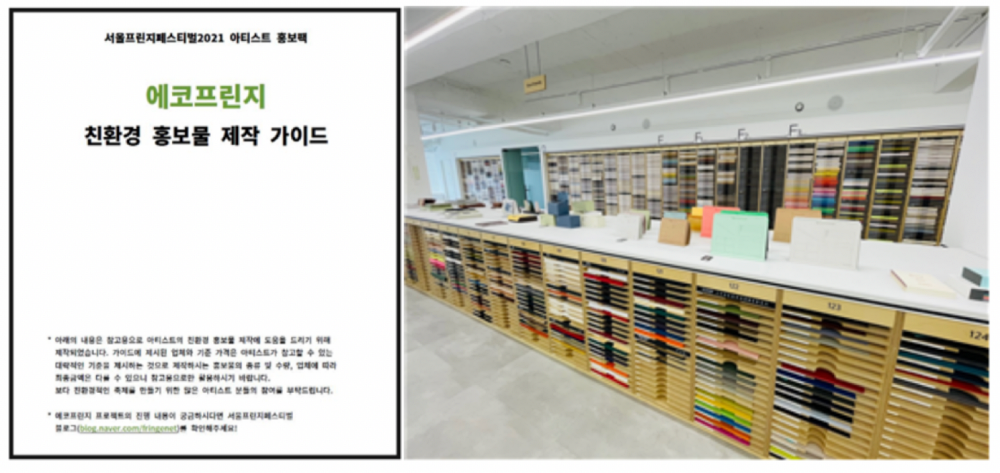
(Source: Seoul Fringe Festival 2024 Blog & Seoul Fringe Network, 2024)
Introduction of Zero Waste Production Methods
During the production stage, various practices were introduced to minimize the environmental impact caused by performance set construction and artwork transportation. For example, in 2022, the ‘Bonobo Project’ developed a checklist aimed at reducing carbon emissions. Participating artists used this checklist to review their creative processes and identify areas for improvement. Additionally, eco-friendly efforts such as sustainable set building, transportation methods, and waste sorting were documented on the project’s introduction pages to encourage audiences to support environmental practices. These changes spread rapidly, particularly among artists working on smaller-scale projects, demonstrating potential for driving structural transformation within the production processes of the performing arts industry.
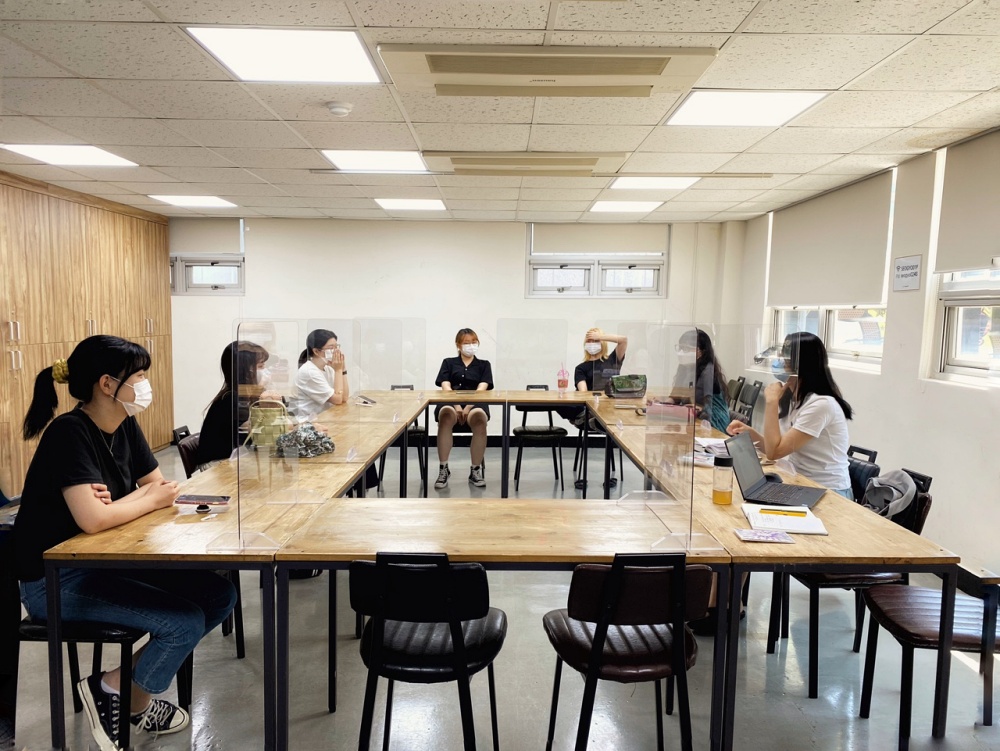
(Source: Fringe Network, 2024)
The festival collaborated with the Munrae-dong-based organization ‘Peace of Peace‘ to experiment with zero-waste production methods aimed at reducing waste. Instead of using leftover scrap materials, they created artworks from the outset using zero-waste principles, presenting projects that combined furniture making with performance art. As part of the ‘Artist Hub Activation Project’, they launched a project called <Makers Yeon-Jang Library>, which provides a space where people can borrow items that are difficult to own individually, promoting a culture of repairing and reusing rather than buying new things. Additionally, through the <Seoul Akkawo Center Lost & Found Rescue Team> project, participants dressed in bright orange uniforms go out into the streets to find abandoned items and immediately repair them on-site, turning the repair process into a form of performance.
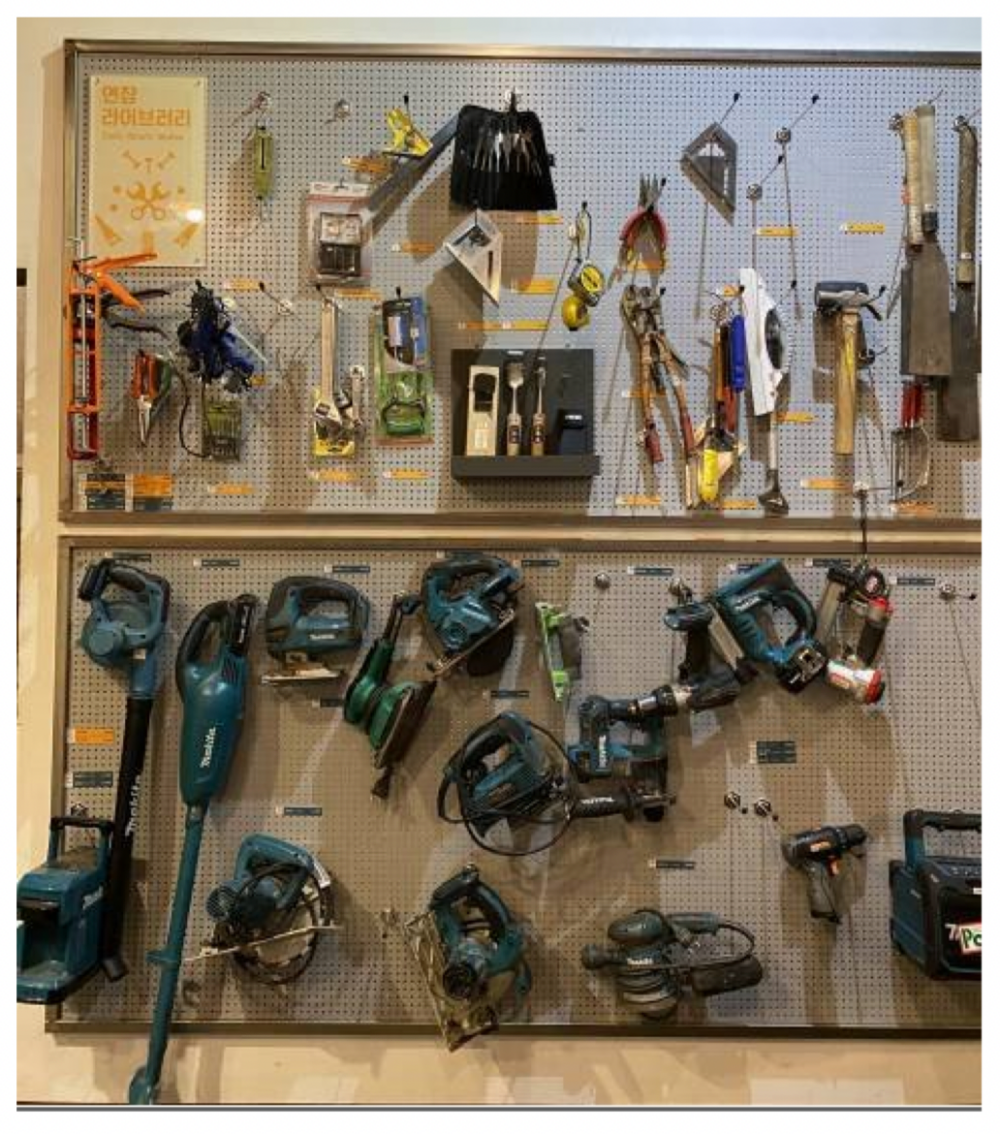
(Source: Seoul Fringe Festival Website, 2024)
Sustainable Management in Festival Operations and Performance Stages
Efforts of the Organizing Team
The Seoul Fringe Festival has made efforts to expand artistic discourse related to the climate crisis through solidarity and collaboration between the arts community and environmental organizations. During the festival, the Eco Fringe team conducted various activities centered on environmental issues, including waste workshops, climate crisis-themed exhibition visits, and trash collection around the festival venue. In particular, they hosted discussion forums such as the <Independent Arts Roundtable>, fostering climate crisis discourse within the arts community and encouraging fellow artists to share environmental awareness. Additionally, programs like <Art Spaces Addressing Climate Change> and the <Anthropocene Art Webinar> were organized to enable domestic and international artists to share their climate-related activities and gain momentum for action through networking.
During the festival operations and performance stages, Seoul Fringe Festival actively adopted sustainable management practices. Various workshops and seminars addressing the climate crisis and environmental issues were held throughout the festival. One notable example is the <Eco Fringe Workshop>, which offered activities such as vegan baking and eco-friendly board games, providing both artists and audiences with hands-on opportunities to engage with and practice environmental awareness.
On-site, the festival distributed maps introducing nearby vegan restaurants and zero-waste shops around the festival area to raise awareness about the climate crisis and encourage eco-friendly actions among attendees. This allowed audiences to experience vegan food and purchase recycled products close to the festival, offering practical ways to incorporate sustainable habits into their daily lives. Additionally, the festival provided vegan lunch boxes and reusable containers within the festival grounds, ensuring even small efforts to reduce carbon emissions were not overlooked.
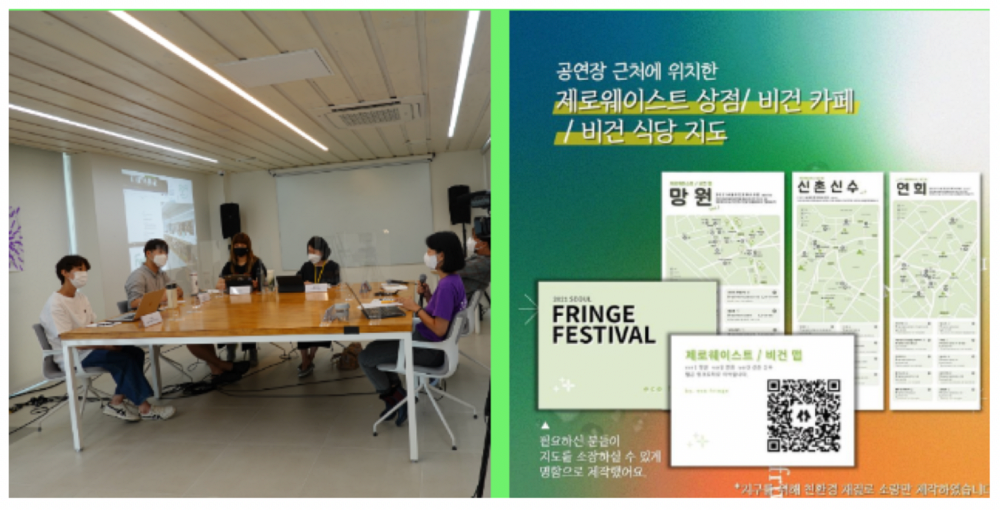
(Source: Geuraedo Fringe Website, 2024)
To reduce waste on-site, designated recycling zones were set up, and volunteers monitored waste output in real time while conducting environmental campaigns. These efforts, aimed at achieving zero waste throughout the festival, went beyond simply enjoying the event—they transformed the festival’s operations and audience experience into actions that actively contribute to environmental sustainability.
Practices of Participating Artists
Participating artists also enriched the festival’s message by incorporating eco-friendly elements into their creative processes. One artist team reused discarded wood and fabric to build a new stage set, while another used natural materials like stones and branches instead of plastic props to express a connection with nature. Among the most notable examples was the performance group ‘Not Eye’. From the production stage, they aimed to minimize waste by using leftover wood and fabric for set construction, and after the performance, they engaged the audience in a recycling performance using the remaining materials. Through this, they raised awareness of environmental issues by showing the recycling process directly to the audience.
In this way, artists not only practiced eco-friendly and carbon-neutral methods during the creative process but also conveyed messages about climate action through their works. Another performance group presented a piece centered on animals threatened with extinction due to climate change, directly raising audience awareness about environmental issues. After the performance, they practiced waste circulation by recycling leftover sets and props together with the audience on-site. Additionally, interviews and activity records of the artists were shared via the festival’s social media channels, helping to spread their eco-friendly messages to a wider audience.
Audience Participation as Partners of the Festival
Audiences participated in various activities that went beyond simply watching performances, actively engaging with the festival’s eco-friendly message. At the festival site, were held to educate attendees on ways to reduce waste. Audience members took part in waste collection efforts and zero-waste practices, deepening their connection to the festival’s environmental values. For example, some joined performances where participants wore orange uniforms to repair abandoned objects on the streets, or took part in shows that recycled leftover materials. Additionally, attendees contributed to reducing plastic use by purchasing food with reusable containers or bringing their own recyclable containers to carry festival souvenirs. They also showed support for the festival’s message by buying eco-friendly items like eco-bags made from discarded banners and vegan snacks prepared during vegan baking workshops.
Post-Festival Phase: Spreading Sustainable Impact
Even after the festival, Seoul Fringe Festival continued its efforts to expand sustainable festival models. Following the conclusion of the event, feedback was collected from participating artists and audiences to analyze the achievements and limitations of the eco-friendly practices and to explore directions for improvement. In particular, the effectiveness of the environmentally conscious measures proposed during the festival was evaluated and incorporated into the festival’s operational manual.
Additionally, the festival helped foster discourse on the sustainable transformation of the festival and performing arts sectors. By participating in the research group, it shared international cases such as the UK’s eco-friendly performance production manuals and proposed concrete methods that the performing arts community can apply to reduce carbon emissions. The festival also collected examples from various performing arts and other genres to question environmentally unfriendly practices within the arts and actively explored ways to transform the festival into a more eco-friendly event throughout its process.
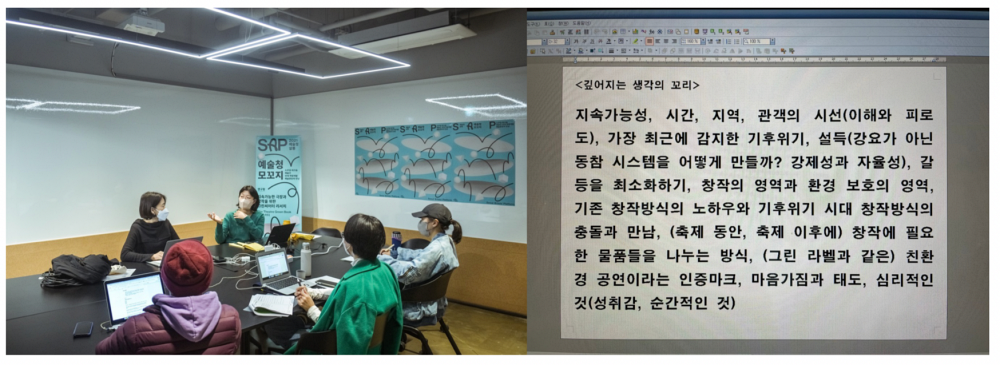
(Source: Fringe Network, 2024)
The Seoul Fringe Festival has also focused on spreading eco-friendly culture through collaboration with the local community. Partnering with <Peace of Peace> in Mullae-dong, the festival shared zero-waste practices and operated spaces and campaigns to promote a culture of repairing and reusing items. Working together with artists, they experimented with production methods that minimize waste generation, aiming to enhance the festival’s sustainability.
The efforts of the Seoul Fringe Festival go beyond simply raising awareness about environmental issues; they represent a significant case of introducing new practices across the arts community and driving tangible changes to reduce carbon emissions. As a value-driven organization, the Fringe Festival differs from established artists, who may find change difficult due to entrenched habits in their creative processes. Many artists participating in the Fringe Festival tend to be freer from such conventions and often belong to generations more concerned about the climate crisis, which leads them to actively engage in carbon-neutral activities. As a result, the festival has successfully hosted an environmentally friendly event focused on carbon reduction.
Conclusion
The Seoul Fringe Festival, founded on free and experimental art, has in recent years embraced sustainability as a core value in its festival operations, making various concerted efforts toward this goal. The Fringe office actively introduced eco-friendly measures such as reducing paper usage, promoting electronic tickets, and using recyclable exhibition materials. Additionally, they minimized venue transfers and enhanced accessibility through public transportation to lower the festival’s carbon footprint. Through collaboration with local communities, these efforts to reduce carbon emissions have helped raise awareness of the importance of sustainability among both audiences and artists.
The festival took environmental responsibility by producing recyclable stage sets and minimizing waste, while encouraging audiences to use reusable cups and reduce plastic through the “Zero Waste Campaign.” After the festival, it demonstrated accountability by calculating and transparently disclosing its carbon emissions. These practices received positive feedback from participants and even resulted in some operational cost savings. Furthermore, the sustainability-focused efforts helped strengthen collaboration with the local community and contributed to building a participatory sustainability model.
Nonetheless, there were clear limitations. Due to the nature of the festival operating on a small budget, it was challenging to fully implement advanced eco-friendly technologies and infrastructure. A lack of support from public policies also posed obstacles to establishing long-term sustainability. The level of sustainability practice among individual artists was uneven, and audience participation had its limits, which meant that eco-friendly campaigns did not become fully ingrained throughout the entire festival. Additionally, there were shortcomings in quantitatively evaluating environmental outcomes and in sharing these insights to expand best practices to other festivals or events.
Despite these limitations, the implications of the Seoul Fringe Festival are clear. It set a precedent that sustainability can be practiced even in small-scale festivals, demonstrating the potential to positively influence similar art events and the performing arts industry. Notably, the festival succeeded not only in integrating sustainability into its operational methods but also in embedding it within its artistic messages, thereby offering audiences new lifestyles and values.
The challenges ahead are clear. Moving forward, it will be essential to overcome these limitations through broader collaboration with various stakeholders and to explore ways to lead eco-friendly practices across the entire arts sector. Additionally, quantifying environmental outcomes and transparently sharing this data will be crucial to demonstrate the festival’s impact and build trust. Above all, a structural approach that integrates sustainability not as a short-term goal but as a long-term vision will be necessary.
The Seoul Fringe Festival serves as an important example that even small-scale festivals can actively engage with both environmental and social values in their practices. Such efforts have the potential to inspire more arts festivals and performances to embrace sustainability. Through this example, despite existing limitations, it reaffirmed the belief that small steps toward sustainability can ultimately lead to significant change.
References
- 그래도, 프린지 2021 – 서울프린지페스티벌 2021 온라인 기록집.
- 동아비즈니스리뷰 (2023.10.05.) ’죽은 지구에 예술은 없다‘ 공연도 이제 지속가능성을 고민해야할 때.
- 서울프린지페스티벌 2024 공식 홈페이지.
- 서울프린지페스티벌 2024 공식 블로그.
- 한국문화예술위원회 (2022) 지속가능한 공연예술 창제작을 위한 안내서.
Suggested Reading










